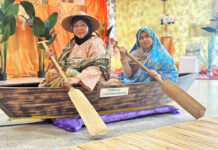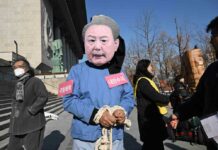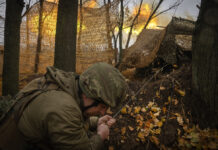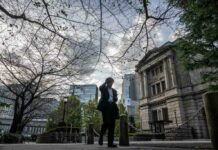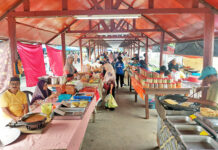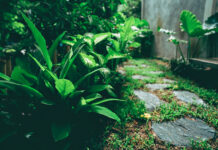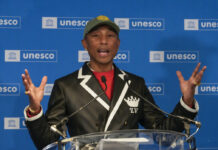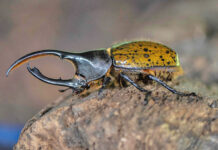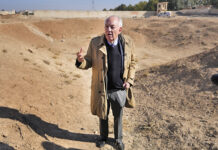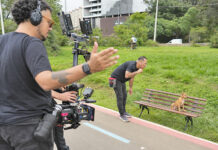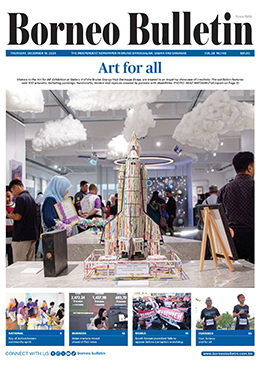Despite lacking formal fine arts education, Chhorn Ravuth sculpts Khmer-inspired masterpieces through the artistic wisdom from fellow monks
(ANN/PHNOM PENH POST) – In the serene corridors of Cheyou Pagoda nestled in Kampong Cham province, venerable Chhorn Ravuth breathes artistic life into clay, skilfully crafting beings and colossal figures of myth and legends with a distinctive Khmer essence.
Despite holding a degree in civil engineering, the monk wholeheartedly embraced his true vocation as a ceramicist, channelling his creative energy into sculptures that resonate with the vibrancy of Khmer artistic tradition.
Born into an agricultural family, his ardour for sculpture manifested at an early age, prompting his entrance into monkhood at Cheyou Pagoda at the tender age of 16.
Following the acquisition of a degree, he dedicated himself to refining his craft under the tutelage of fellow monk Sim Chandara in the remote Oddar Meanchey province, only to return to the hallowed grounds of the pagoda in 2020, where his artistic journey had begun.
“I didn’t go to a fine arts school; instead, I learned from a monk. He took the time to teach me, sharing knowledge and guiding me in artistic styles through practices,” he shares.

Ravuth says that in 2020, at the start of the COVID-19 pandemic when travel was limited, he started sculpting in the Khmer art style, creating diverse sculptures.
Currently, he has completed sculptures portraying the creation myth known as “The Churning of the Ocean of Milk” and a dragon. He is also currently sculpting a Buddha.
“Creating ceramic sculptures requires precise sizing; it’s a meticulous task. I adhere carefully to the modelled size, evaluating the shape for suitability. If it doesn’t align correctly, adjustments are made accordingly,” he says.
Clay’s silent dance
For sculpting, the monk shares that he uses clay from Kampong Chhnang, a province best known for fine clay pottery. This choice is based on its durability and absence of gravel, characteristics typically found in clay used for crafting kitchen utensils.
Gravel-free clay is essential in pottery as its inclusion can interfere with the shaping process. Cost-wise, a 50 kilogramme (kg) bag of clay is priced at KHR100,000 (USD25), and creating one sculpture requires 200kg of clay. The funds for purchasing the clay are provided by the pagoda’s chief monk.
He explains that each sculpture is meticulously crafted by hand and then replicated using a template. This artistic process combines imaginative intuition with a careful examination of the artwork being created. While inspired by the style of temple sculptures, his creations aim for a resemblance to the original, although not a 100 per cent exact replica.

“Pottery and ceramic sculpting differ from other forms of imaginative sculpture because in imaginative sculpture, we follow our thoughts and ideas. On the contrary, when adhering to a specific modelling style, we must carefully examine and incorporate all the details of the original form,” Ravuth explains.
Ravuth shares that he currently serves as a Pali language teacher at the primary school inside Wat Yo pagoda in Speu commune.
Alongside this role, he is assembling instructional materials, including books provided by the Department of Culture and Fine Arts, to educate young people aspiring to further their artistic knowledge and skills.
Cultural mastery
Rat Tysak, deputy director of the Kampong Cham provincial Department of Culture and Fine Arts, observes during his visit to Cheyou Pagoda that all the statues crafted by the monk adhere to authentic Khmer art forms and showcase exquisite ornamental designs.
Recognising this skill as a valuable resource for preserving ceramic expertise, the department has provided him with books showcasing intricate sculptures of Khmer art. These books also serve as documentation to aid in teaching younger generations.
“Upon inspection, I noted that he has executed his designs accurately. Furthermore, he knows how to craft soft silicone moulds; upon removal, the positive remains undamaged and possesses depth. However, in the case of some moulds, the resulting pieces are hollow rather than deep. If any ornamentation is too deep, there is a risk of breakage upon removal. Observing these details brings me joy,” Tysak says.
He shares that the department actively supports this endeavour by motivating him to persist in his work. Recognising the significance of individuals engaged in artistic pursuits across different regions, the department consistently promotes the value of all forms of art and provides reference materials to enhance their understanding and appreciation of each artistic form.





